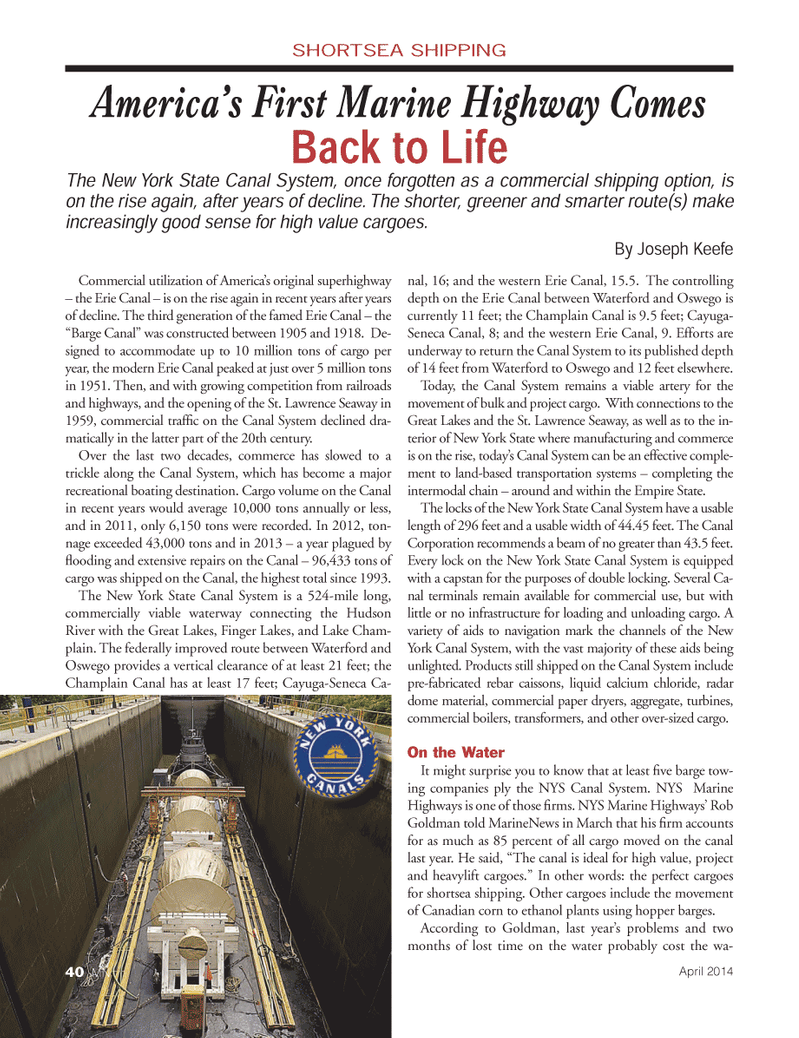
Page 40: of Marine News Magazine (April 2014)
Shipyard Report: Construction & Repair
Read this page in Pdf, Flash or Html5 edition of April 2014 Marine News Magazine
SHORTSEA SHIPPINGCommercial utilization of America?s original superhighway ? the Erie Canal ? is on the rise again in recent years after years of decline. The third generation of the famed Erie Canal ? the ?Barge Canal? was constructed between 1905 and 1918. De- signed to accommodate up to 10 million tons of cargo per year, the modern Erie Canal peaked at just over 5 million tons in 1951. Then, and with growing competition from railroads and highways, and the opening of the St. Lawrence Seaway in 1959, commercial traf c on the Canal System declined dra- matically in the latter part of the 20th century. Over the last two decades, commerce has slowed to a trickle along the Canal System, which has become a major recreational boating destination. Cargo volume on the Canal in recent years would average 10,000 tons annually or less, and in 2011, only 6,150 tons were recorded. In 2012, ton- nage exceeded 43,000 tons and in 2013 ? a year plagued by ooding and extensive repairs on the Canal ? 96,433 tons of cargo was shipped on the Canal, the highest total since 1993.The New York State Canal System is a 524-mile long, commercially viable waterway connecting the Hudson River with the Great Lakes, Finger Lakes, and Lake Cham- plain. The federally improved route between Waterford and Oswego provides a vertical clearance of at least 21 feet; the Champlain Canal has at least 17 feet; Cayuga-Seneca Ca- nal, 16; and the western Erie Canal, 15.5. The controlling depth on the Erie Canal between Waterford and Oswego is currently 11 feet; the Champlain Canal is 9.5 feet; Cayuga- Seneca Canal, 8; and the western Erie Canal, 9. Efforts are underway to return the Canal System to its published depth of 14 feet from Waterford to Oswego and 12 feet elsewhere. Today, the Canal System remains a viable artery for the movement of bulk and project cargo. With connections to the Great Lakes and the St. Lawrence Seaway, as well as to the in- terior of New York State where manufacturing and commerce is on the rise, today?s Canal System can be an effective comple- ment to land-based transportation systems ? completing the intermodal chain ? around and within the Empire State. The locks of the New York State Canal System have a usable length of 296 feet and a usable width of 44.45 feet. The Canal Corporation recommends a beam of no greater than 43.5 feet. Every lock on the New York State Canal System is equipped with a capstan for the purposes of double locking. Several Ca- nal terminals remain available for commercial use, but with little or no infrastructure for loading and unloading cargo. A variety of aids to navigation mark the channels of the New York Canal System, with the vast majority of these aids being unlighted. Products still shipped on the Canal System include pre-fabricated rebar caissons, liquid calcium chloride, radar dome material, commercial paper dryers, aggregate, turbines, commercial boilers, transformers, and other over-sized cargo. On the Water It might surprise you to know that at least ve barge tow- ing companies ply the NYS Canal System. NYS Marine Highways is one of those rms. NYS Marine Highways? Rob Goldman told MarineNews in March that his rm accounts for as much as 85 percent of all cargo moved on the canal last year. He said, ?The canal is ideal for high value, project and heavylift cargoes.? In other words: the perfect cargoes for shortsea shipping. Other cargoes include the movement of Canadian corn to ethanol plants using hopper barges.According to Goldman, last year?s problems and two months of lost time on the water probably cost the wa- America?s First Marine Highway Comes America?s First Marine Highway Comes Back to Life The New York State Canal System, once forgotten as a commercial shipping option, is on the rise again, after years of decline. The shorter, greener and smarter route(s) make increasingly good sense for high value cargoes. By Joseph Keefe April 201440 MNMN April14 Layout 32-49.indd 40MN April14 Layout 32-49.indd 403/21/2014 12:07:33 PM3/21/2014 12:07:33 PM

 39
39

 41
41
